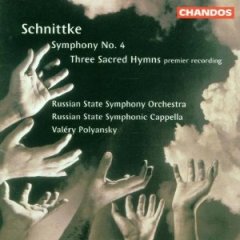Schnittke - Symphony Nr. 4, Three Sacred Hymns (Polyansky) [1996]
Schnittke - Symphony Nr. 4, Three Sacred Hymns (Polyansky) [1996]

Three Sacred Hymns 1. Hail to the Holy Virgin 2. Lord Jesus, Son of God 3. Our Father (The Lord's Prayer) 4. Symphony No. 4 Iaroslav Zdorov – countertenor Dmitri Pianov - tenor Igor Khudolei - piano Evgeniya Khlynova - celesta Elena Adamovich – harpsichord Russian State Symphonic Cappella Russian State Symphony Orchestra Valéry Polyansky – conductor
This Chandos disc leads off with the "Three Sacred Hymns," sung by the Russian State Symphonic Cappella. These are haunting and prayerful, and serve as a perfect introduction to one of Schnittke's most perfectly realized works, Symphony No. 4 (1984). Valery Polyansky leads the Russian State Symphony Orchestra, recorded in Moscow in 1994. Polyansky's entire series of Schnittke recordings for Chandos is superb.
The liner notes by Ronald Weitzman are very helpful in untangling the single movement work's complexities, but go into such detail as to lose the forest for the trees in terms of what the Symphony actually sounds like. It tells the story of Christ's life through Mary's eyes, following the Catholic Rosary. (Schnittke converted to his mother's Catholicism late in life, though he tended to rely more on Russian Orthodox elements in his sacred music.) It begins slowly and mysteriously, the sound of prayer, and gradually grows louder and more complex, culminating successively in two great terror-filled climaxes, the second of which marks the Crucifixion. Building on Beethoven and Mahler's symphonic innovations incorporating vocals, Schnittke uses not only tenor and countertenor voices at key junctures, and a chorus for the finale, but also features passages that sound like a piano concerto. A trio of piano, celesta and harpsichord is subtly featured throughout the work, but the piano takes dramatic solo turns as the crescendos build.
In the end, of course, comes the Resurrection, as Love triumphs over Evil. The chorus sings Ave Maria, "Hail to the Holy Virgin," recapituating the first of the "Three Sacred Hymns." Bells chime and there is a strong sensation of being carried out of a church where the choir sings, up and out on the bells toward God.
Symphony No. 4 is elaborately and carefully constructed, both musically and in terms of religious symbolism. Schnittke uses themes representing the three main strands of Christianity -- Orthodox, Catholic and Protestant -- as well as a theme representing Judaism, and interweaves them. Out of these themes he constructs a plot that follows the Rosary through the states of Joy, Sorrow and Glory, and each of these contains five episodes, telling the story of Christ's birth, life, death and resurrection. --- R. Hutchinson
download: uploaded yandex divshare 4shared mediafire solidfiles mega zalivalka filecloudio anonfiles oboom
Last Updated (Friday, 25 April 2014 20:02)








